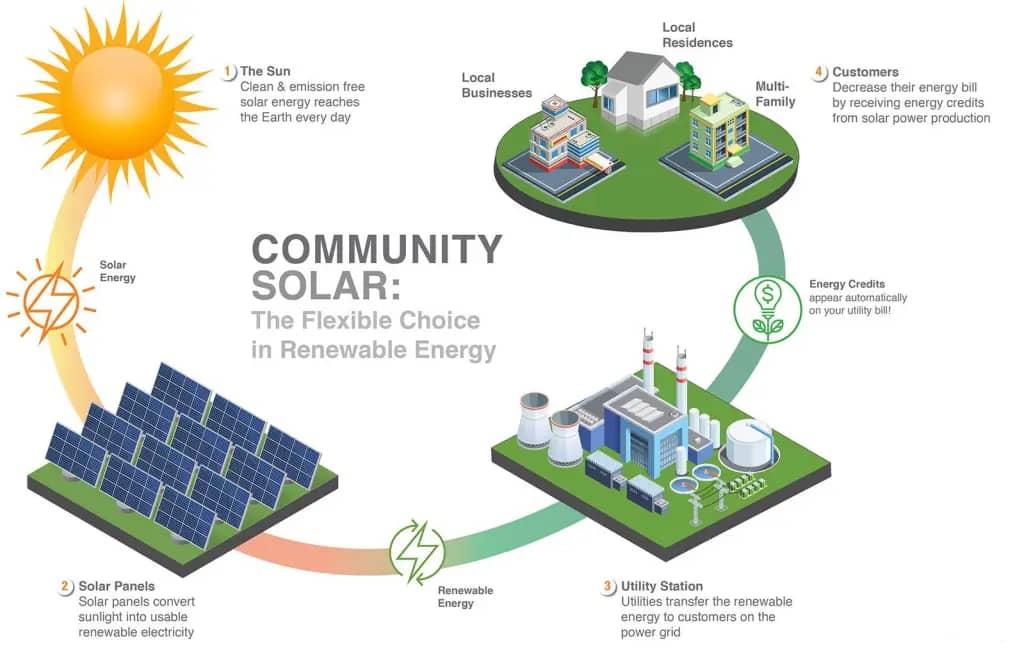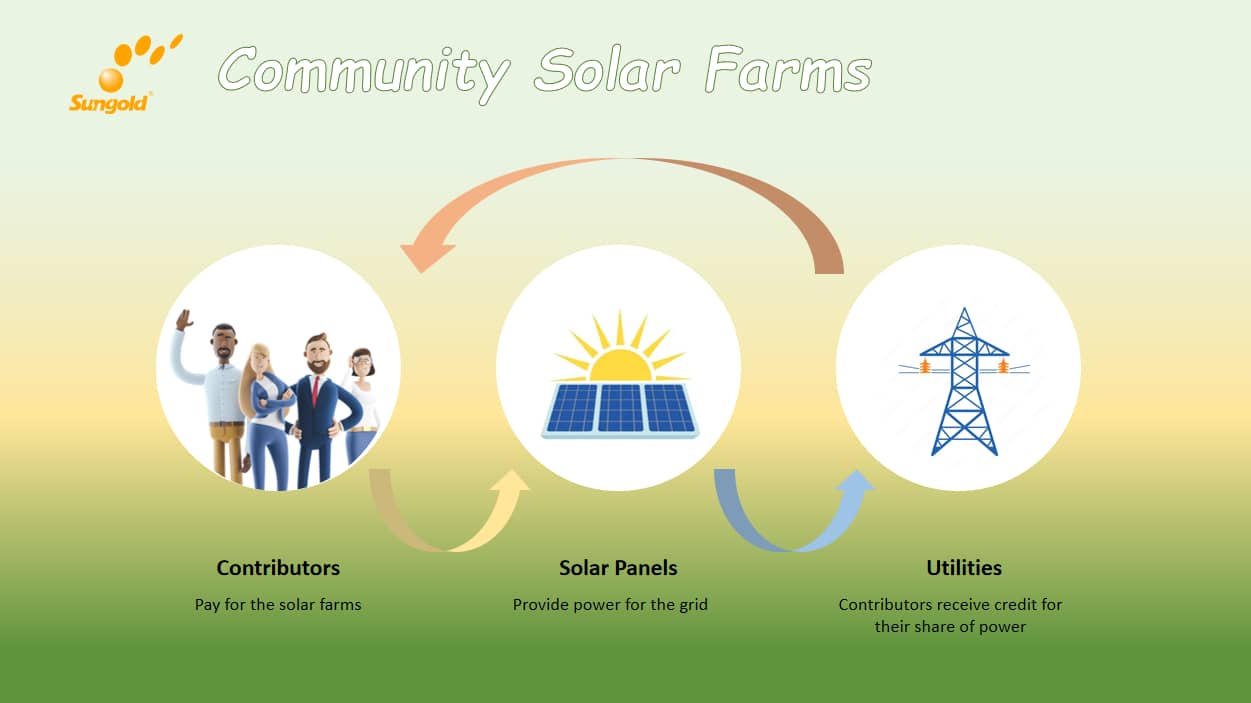Two types of photovoltaic systems exist in the US: distributed and centralized. Both have pros and cons.
However, there is a new type called community solar that can overcome the drawbacks of both. This new mode can solve the issues of PV’s volatility, difficulty in connecting to the grid, and economic problems. It offers a solution to these problems that have been present for over a decade.
Today to talk to you what is community solar, its working principles, and their advantages.
What is Community Solar?
Community solar, also known as solar gardens or roofless solar, refers to shared solar power systems. These systems allow multiple individuals to benefit from a single solar installation. The concept was developed to make solar energy accessible to people who may not have the financial means or suitable property to install solar panels on their own.
Community PV combines the benefits of distributed and centralized PV, avoiding the drawbacks of distributed PV plants.

How Does Community Solar Work?
Community solar farms let many people or businesses benefit from one big solar installation.
Here’s a step-by-step breakdown of how it works:
- We installed a large solar farm on a plot of land. This setup has many rigid solar panels that can produce a lot of electricity.
- Subscription: Individuals or businesses in the community subscribe to the solar farm. People can buy panels or electricity from the farm.
- Generation: The solar panels in the farm convert sunlight into electricity. We know this process as photovoltaic energy generation.
- The farm sends the electricity it generates to the power grid. The utility company monitors the amount of electricity each subscriber’s panels produce.
- Billing: Subscribers receive credits on their utility bills for the electricity their share of the solar farm produces. If their panels produce more electricity than they use, they may even receive a credit from their utility company.
Community solar farms provide renewable energy to individuals who are unable to afford their own solar installations. This includes homeowners with shaded roofs or renters who do not own their homes.
Is Community Solar Worth It?
Community solar can be a worthwhile investment depending on your specific circumstances. Here are some pros and cons to consider:
Pros of Community Solar
More Reliable Layout of Sites
Photovoltaic has many benefits, but installing it requires a lot of open space. Nowadays, there are stricter policies on using land for photovoltaic installations to protect farmland.
The national policy explicitly forbids using farmland for photovoltaic projects. That’s why distributed photovoltaic systems are being installed on rooftops in rural areas. However, this limits power generation and poses obvious security risks.
Photovoltaic Storage Integration
Solar power depends on the weather. It can produce more electricity on sunny days and less on rainy days. This can cause problems for the power grid.
It can change the voltage and frequency. It can also result in too much or too little electricity at different times.
Energy storage can store excess electricity and release it when there is a shortage, helping to solve energy problems. It can also balance the voltage and frequency, and adjust the supply and demand of electricity.
Our community uses solar power with energy storage. We have a system that combines solar panels and batteries. We use a type of battery that is cheap and efficient.
It gives power at night, makes solar power last longer, and makes the grid more flexible. It can also respond quickly to the needs of the grid, such as reducing the peak demand or increasing the low demand.
This way, we can use solar power more smoothly and meet the electricity needs of the community. We can also sell the extra electricity to the grid more easily.
Besides, we have another type of energy storage that stores hot water. It does not need to turn the heat into electricity, but it can use hot water to cool or heat the air. This type of energy storage is cheaper, more reliable, and more convenient.
Low Carbon Emission Reduction
Community solar energy is a good idea as it allows people to use solar power in their homes and buildings.
For example, community solar energy can provide hot water heating for the winter, and cooling for the summer. This way, people do not need to use coal or gas, which produces carbon dioxide, or air conditioners, which leak harmful gases. Community solar energy is a smart and green way to save energy and reduce carbon emissions. It can make our buildings and our planet healthier and happier.
Flexible Distribution of Capacity and Energy Supply
Centralized photovoltaics transmit electricity to the city through high-voltage lines, making it difficult for nearby consumption. On the other hand, distributed photovoltaics are mostly self-generated and used for self-consumption. However, the amount of power generated is limited, and selling electricity to the grid is also limited. In rural areas, solar water heaters installed on roofs provide hot water for families.
Community-based PV can provide a bigger capacity, including planned capacity, energy storage, and energy supply to the community. This helps prevent a mismatch between supply and demand and avoids having too much capacity.
Communities and villages form the basis of community PV energy storage, rather than individual households. This makes the capacity link more systematic and flexible for energy use and deployment.
More Economic Benefits
The US solar industry has been growing for a long time and has the highest installed capacity in the world. However, solar energy makes up a small portion of the overall energy share.
This limits the growth of the solar industry. One reason for this is that farmland cannot accommodate solar panels. There are also other factors affecting the solar industry.
Cons of Community Solar
Availability
Community solar isn’t yet available in every state.
Incentives
You likely won’t be able to take advantage of most incentives as a solar subscriber.
Consider monthly bills and long-term savings when deciding to join a community solar program for energy cost savings. If you own your property, purchasing your solar system can be a better long-term investment. If you can’t install solar panels where you live, community solar might be a good alternative for you.
Utility-Scale Solar vs Community Solar
Community solar farms and distributed photovoltaic (PV) systems are both forms of solar energy deployment, but they operate differently and serve different purposes.
| Aspect | Community Solar Farms | Distributed Photovoltaic (PV) |
| Ownership | Shared ownership by multiple participants who receive credits. | Individual or business-owned solar panels. |
| Access to Solar Energy | Available to participants who can’t install solar panels on their property. | Installed on individual properties, providing direct access. |
| Installation Location | Located off-site, often in a central location accessible to participants. | Installed on rooftops, ground, or other available spaces at the point of use. |
| Cost | Typically lower upfront costs due to shared infrastructure. | Higher upfront costs, but potential for long-term savings. |
| Maintenance | Managed and maintained by the community solar provider. | Individual system owners are responsible for maintenance. |
| Energy Bill Savings | Participants receive credits or reduced energy bills for their share of the solar energy generated. | Direct savings on energy bills through self-consumption and excess energy export. |
| Scalability | Limited by the capacity of the community solar farm. | Scalable based on available space and budget. |
| Environmental Impact | Reduces the carbon footprint of multiple participants. | Reduces the carbon footprint of individual property owners. |
| Flexibility | May be less flexible in terms of system design and location. | Offers more design flexibility for individual property owners. |
| Incentives and Rebates | May offer incentives and rebates specific to community solar. | Eligible for government incentives and rebates for PV installations. |
| Return on Investment (ROI) | May have a longer ROI due to shared benefits. | Potentially faster ROI based on electricity savings. |
| Grid Dependency | Relies on the grid for power distribution. | Can operate independently or with grid connectivity. |
| Local Community Impact | Strengthens the community’s commitment to renewable energy. | Demonstrates individual commitment to sustainable energy. |
| Legal and Regulatory Considerations | May involve specific agreements and regulations related to community solar. | Subject to local regulations and permitting for PV installations. |













